The MRO Department of Outreach and Communications has released nine new desktop wallpapers for free download, follow the link below to get your favorite!
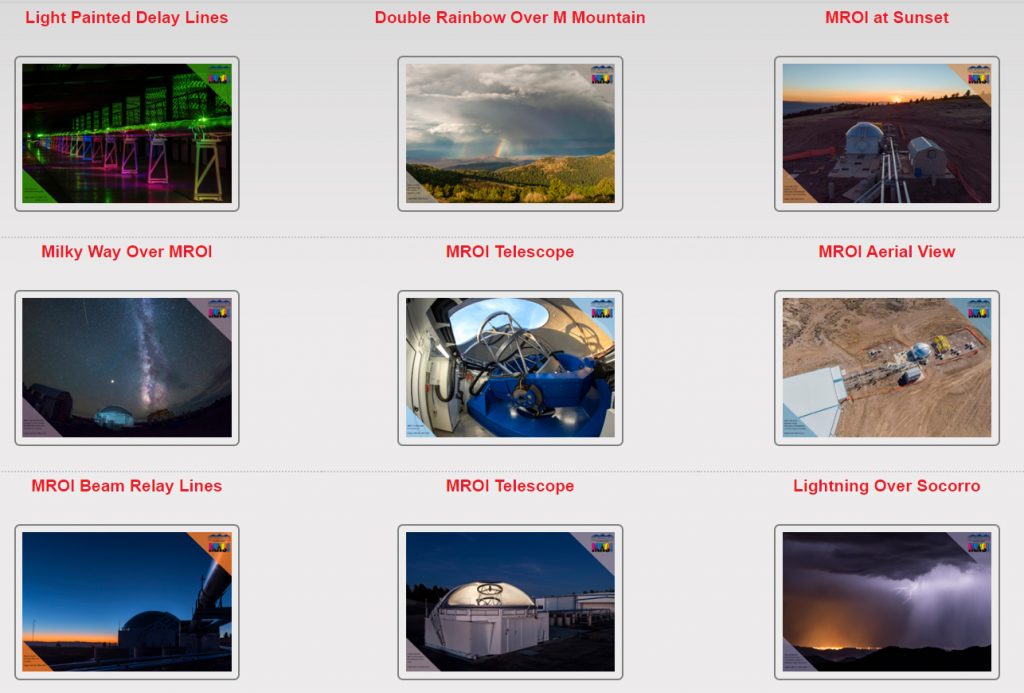
M. Colleen Gino, MRO Assistant Director of Outreach and Communications

Daily Astronomy Edutainment
Ever wonder how many Wanderers you can see in the sky at once? This coming week you may just find out!
Look to the south about an hour before sunrise this week and you may see the Wanderers Mercury, Venus, Mars, Saturn, and Jupiter spread across the sky from the ENE to the WSW. All but Mercury should be visible to the naked-eye; for Mercury you’ll need binoculars or a small telescope. You’ll also need a very clear horizon without obstructions, as Mercury and Jupiter will be quite low in the sky.
Why do we refer to the planets as the Wanderers? Ancient Greek astronomers were keen observers of the night sky, and noted that there were a handful of celestial objects that moved relative to the background of “fixed” stars. These “planetai”, as they were called, traveled along a fairly narrow band of the sky around the ecliptic, the imaginary line that marks the annual path of the Sun. Planetai is translated as wanderers; the name planet comes from this Greek word.
Starting low in the ENE sky we find Mercury, named after the ancient Roman Mercurius, god of financial gain, commerce, and travelers. Being the closest planet to the Sun, Mercury is quite a speedy traveler, completing its orbit around the Sun in a mere 88 days. Mercury will be less than 5° degrees above the horizon and 15° degrees to the east of Betelgeuse, a bright red giant star in the constellation of Orion the hunter. This is where the trick of using your hand as a measurement tool will come in handy. When you make a fist and extend your arm all the way out, the distance between your pointer and pinky finger knuckles is about 5°. With this in mind, you can expect Mercury to be about a fist above the horizon and three fists to the left of Betelgeuse.
Next in our line of Wanderers is the brilliant planet Venus, goddess of beauty and love in Roman mythology. Venus will be easy to spot not only because it is the brightest object you will see in this part of the sky, but because it lies only 4° away from Aldebaran, a bright red giant star that marks the eye of Taurus the bull.
Taking center stage in our group is the red planet Mars, which can be found 55° degrees above the SSE horizon. In ancient Roman myth, Mars was the god of war; perhaps this planet was associated with war and bloodshed due to its strikingly reddish hue. The red hue of Mars is easily distinguishable now, and will become more so as it approaches opposition, the point in its orbit when the Earth is directly between it and the Sun, on October 13th of this year.
The ringed beauty Saturn is next on our list. Saturn is named after the Roman god Saturnus, god of plenty, agriculture and wealth. One thing Saturn has plenty of is rings – more than 30! While Saturn is easily seen with the naked-eye, you’ll need a small telescope to make out its ring system, which is made up of billions of small chunks of dusty ice and rock.
Although last in this planetary lineup, Jupiter is hardly last on anyone’s list, especially not the ancient Romans! As the god of sky and thunder, Jupiter was the main deity of ancient Roman religion. With the aid of a small telescope you can spot its four largest satellites Io, Europa, Ganymede and Calisto, depending upon where they are in their orbit around their parent planet. You may even be able to spot one or two of these Jovian moons with binoculars.
I hope you’ve enjoyed our promenade through the planets. Whether or not you’re a natural early bird, this planetary quintet is definitely worth waking up early for!
M. Colleen Gino, MRO Assistant Director of Outreach and Communications
People all over the world have been trying to catch a of glimpse of Comet NEOWISE since news of its viewability hit the media early in the month. We avid sky watchers at New Mexico Tech’s Magdalena Ridge Observatory caught our first peek in the early morning hours of July 8 and have been looking out for it since.

The image below was taken at 4:40 AM MDT on July 9 by MROI staff members Dylan Etscorn and Colleen Gino in San Antonio, New Mexico. They were using a Nikon D850 on MROI’s Bachman-Challener Outreach Telescope, a 100mm Takahashi Refractor purchased with funds donated to the MRO Outreach Department in 2017.
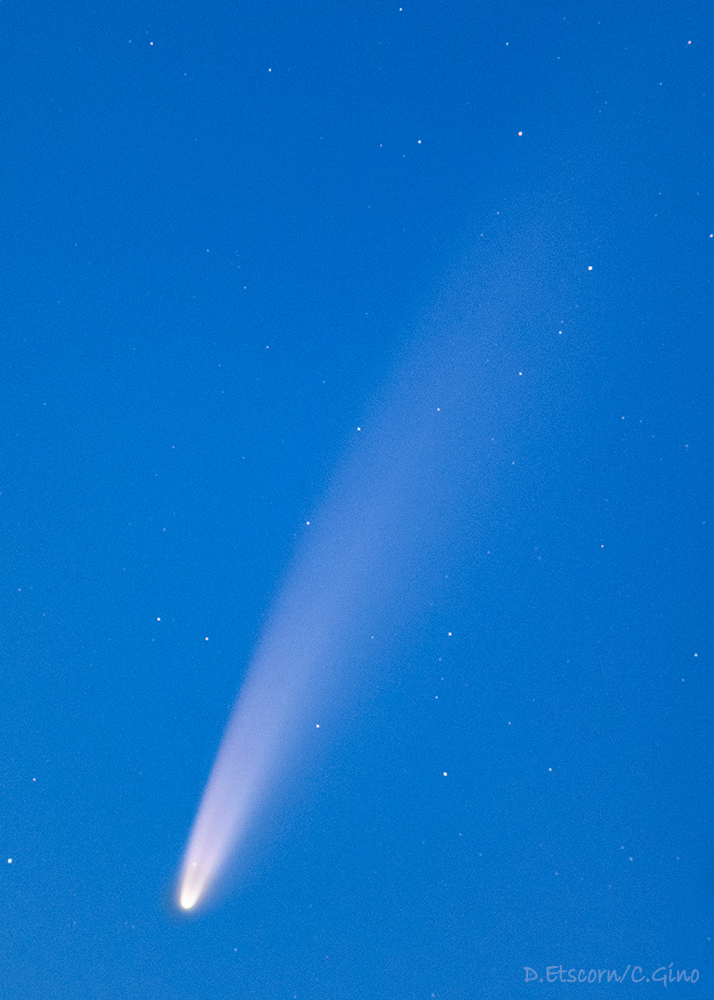
On the morning of July 10, they traveled to San Marcial. New Mexico, in the wee hours of the morning to photograph Comet NEOWISE from a trestle bridge, seen below.
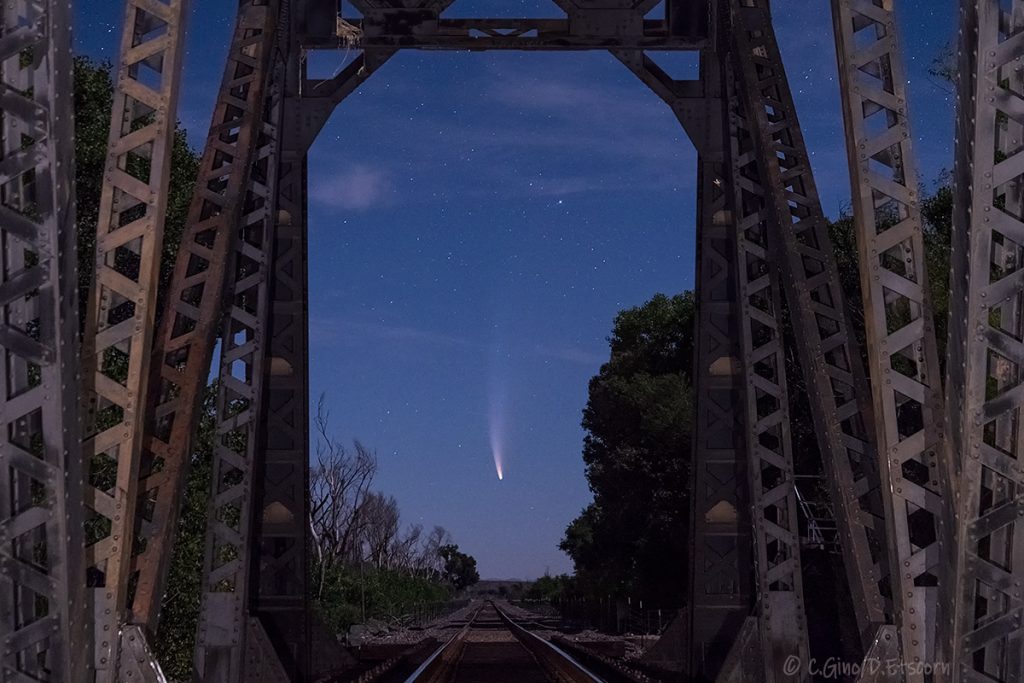
With several successful comet encounters under their belts, Dylan and Colleen took the trek up to the Magdalena Ridge Observatory on July 11th with hopes of photographing the comet over the city of Socorro 6,000 feet below. Although the skies were pristinely clear that evening, by the early morning when the comet would be visible monsoon clouds had rolled in and almost totally obscured the comet from view. The view you see in the image below was to be the last morning view of Comet NEOWISE for our enthusiastic observers.
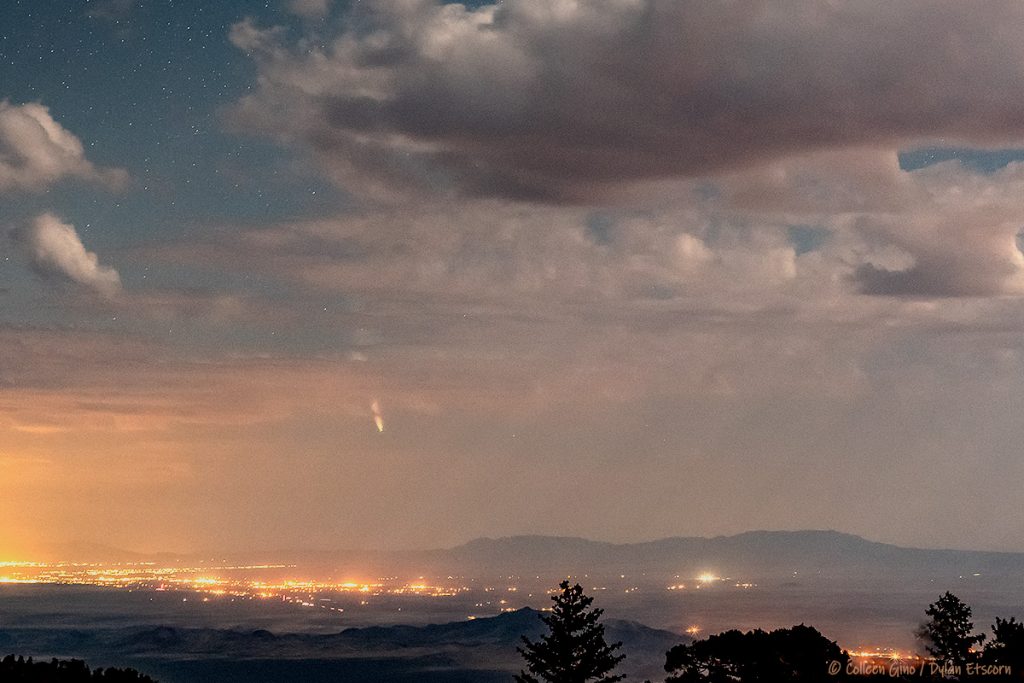
Their next observation of the comet was made almost a week later on July 18, this time in the evening at about 10 PM MDT from a neighborhood with many street lights. While not photographically impressive, this view, seen below, gave our astrophotographers the information they needed to know when and where to look for Comet NEOWISE on future observing expeditions.
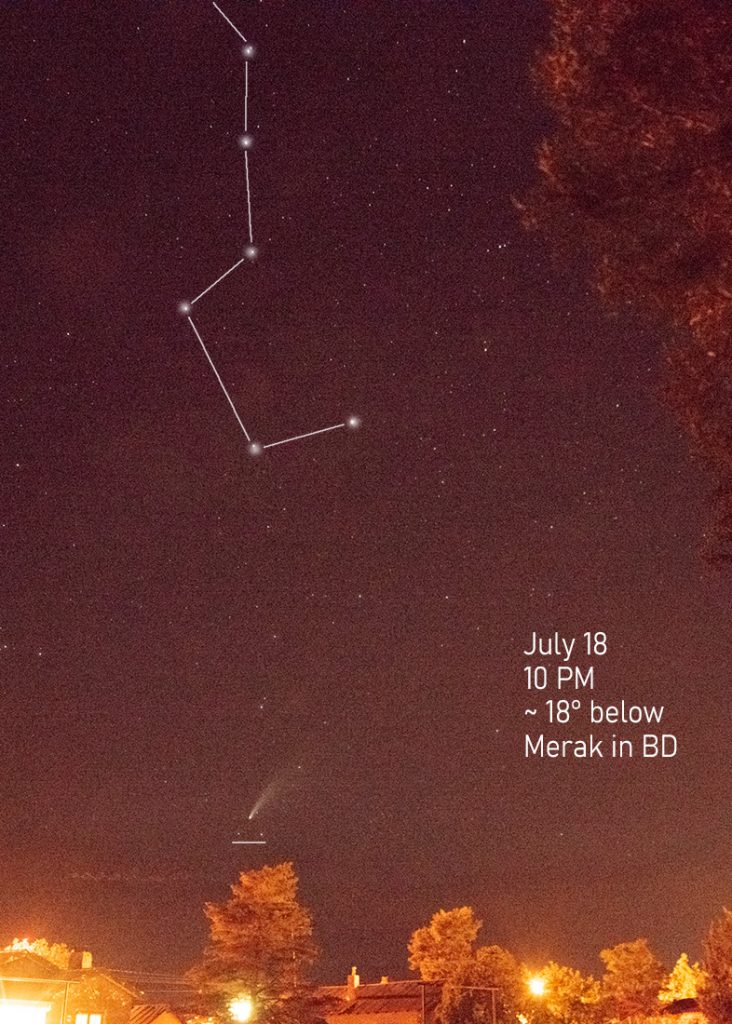
Now knowing where to look, they immediately packed up their gear and drove to darker site, excited to photograph the first evening apparition of the comet, especially since the ion tail was finally visible. But once again the cloudy monsoon skies prevailed, and by the time they got to their dark sky site a mere 10 minutes after their first sighting under the street lights, Comet NEOWISE was mostly obscured by clouds.
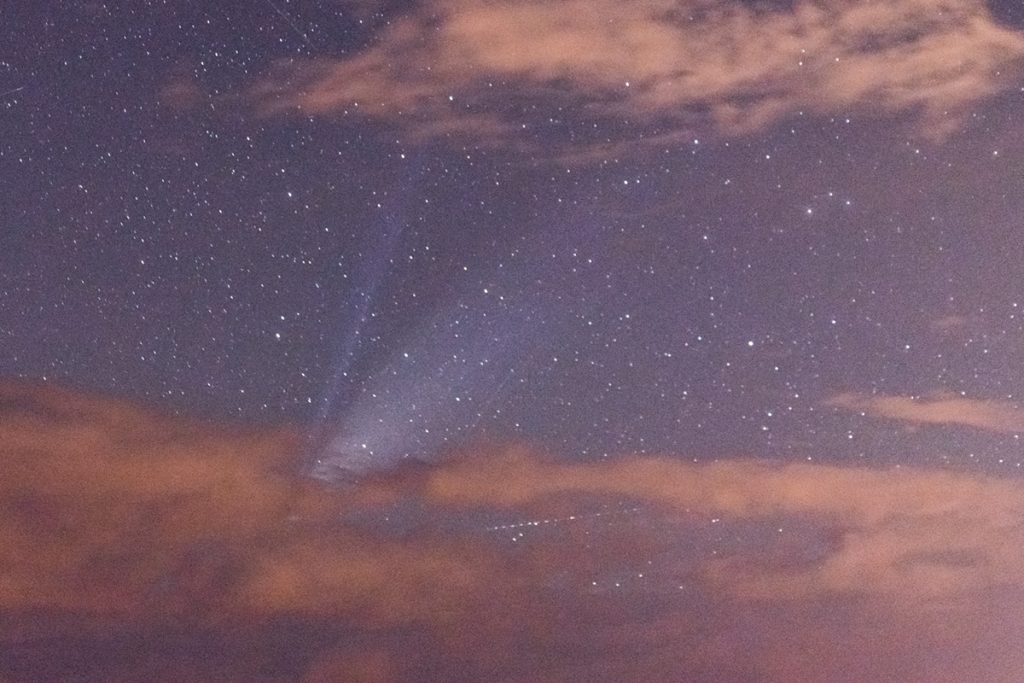
At this point we’re keeping our fingers crossed for some clear moments in our seasonally cloudy skies!
M. Colleen Gino, MRO Assistant Director of Outreach and Communications
Have you ever wondered why the Magdalena Ridge Observatory Interferometer (MROI) is being built in such a way the the telescopes will be movable along the array? Or what it takes to keep the narrow, winding dirt road up to the Magdalena Ridge Observatory (MRO) in tip-top shape? How was MROI instrumental in offering COVID-19 aid relief to the Alamo Navajo Reservation in Socorro County, New Mexico? You can find the answers to these questions and many more in our latest newsletter!
The MRO Biannual Special Edition July Newsletter is available for free download on our website here! You can also download newsletters from previous months and learn about light painting (June 2020), read about an MRO Open House visitor’s experience at the Observatory (May 2020), and find out about one of MROI’s student employee’s experiences working with the MROI team (May 2020).
Each month the MROI newsletters are delivered directly to the email inbox of the members of our Friends of Magdalena Ridge Observatory on the first of the month. The newsletter is released to the general public a few weeks later, and made available for download on the MRO website. If you are interested in hearing our news on the first of each month, please consider becoming a member of Friends of MRO! Follow this link for more information.
M. Colleen Gino, MRO Assistant Director of Outreach and Communications
What do constellations and asterisms have in common, and in what ways do they differ? Keep reading to find out!
Today we’re going to take a look at the Summer Triangle, a grouping of three stars that is visible through the summer months in the northern hemisphere. If you’ve never heard of the constellation Summer Triangle that’s to be expected because it’s not a constellation, it’s an asterism.
Constellations and asterisms are similar in that they both refer to a recognizable pattern of stars visible to the naked-eye. However, a constellation is more; it is an officially recognized designation that refers not only to the pattern of visible stars but to a well-defined area of the sky surrounding those stars. These areas of the sky are designated by the International Astronomical Union, the recognized authority responsible for assigning designations and names to celestial objects.
The Summer Triangle is made up of the stars Altair, Deneb, and Vega, the brightest stars in the constellations Aquila, Cygnus, and Lyra respectively. The Milky Way runs through the Summer Triangle like a stream of sparkling stars, and appears brightest when it is directly overhead around 1 AM at this time of year. But you don’t have to stay up into the wee hours of the night to see this dazzling set of stars. At a fairly dark sky site such as ours at New Mexico Tech’s Etscorn Campus Observatory in Socorro, NM, Altair, Deneb, and Vega are bright enough to be seen during Nautical Twilight which starts about an hour after sunset (sunset is at 8:20 PM tonight). Summer Triangle visibility this evening is helped by the Moonless sky – the Moon doesn’t rise until 2:35 AM tomorrow morning, and even then it is only 17% illuminated so will not significantly add to the sky brightness.
At 9:15 PM tonight (the time on the sky chart above) the Summer Triangle will be visible toward the ENE. Vega, the brightest of the three stars, will be about 55° above the horizon; Altair and Deneb will be 30° and 35° above the horizon, respectively.
This is a good time to take a moment to talk about how to measure distances in the sky using nothing but your hands! Fully extend your arm out in front of you and make a fist. The distance between your pointer finger and pinky knuckles covers a distance of about 10° in the sky. Three fists up from the horizon will closely measure the altitude of Altair in Aquila as illustrated on the attached sky chart. We’ll be talking about more hand distance measurements in the near future.
Unfortunately, after checking today’s local weather forecast I suspect that we’re going to be socked in tonight with monsoon clouds, so tonight may not be the best night for observing the sky. However, you can continue to refer to the attached sky chart with a little modification; for every day later than the date on the chart, the stars will be about 1° higher in the sky at the same time of the chart. Stars rise four minutes earlier each day because of the stars’ annual motion, which is due to the Earth’s revolution around the Sun. This annual motion is not to be confused with a star’s diurnal or daily motion, which is due to the Earth’s rotation on its axis, and is the reason the stars seem to travel through the sky from east to west over the course of a night. Moreover, these two types of a star’s apparent motion are not to be confused with a star’s proper motion, intrinsic motion, or its motion due to the precession of the Earth. But that’s a discussion for another day!
Later in the summer we’ll visit the Summer Triangle asterism once again, when it will be high in sky much earlier in the evening (recall that stars rise four minutes earlier each day). At that time, we’ll take a closer look at the various kinds of celestial objects that we can see with just a pair of binoculars, from a stunning double star to clusters of thousands of stars to clouds of gas ejected by dying stars. Meanwhile, cross your fingers for a break in the clouds in the coming days so we can get a glimpse of the Summer Triangle!
M. Colleen Gino, MRO Assistant Director of Outreach and Communications
Today we honor Dame Susan Jocelyn Bell Burnell, the astronomer who, as a postgrad student, co-discovered an exotic type of celestial object, the pulsar.
At the time of her discovery in 1967, Bell Burnell was working on her Ph.D. in Physics at the University of Cambridge under the guidance of Anthony Hewish. She helped to construct and then operate a radio telescope that was used to study quasars, extremely luminous objects powered by supermassive black holes found in the center of some galaxies. At that time, the data that was gathered from their radio observations was not digitally written to a storage medium as it is today, but was printed out on chart paper – literally miles and miles of chart paper.
One of Bell Burnell’s duties was to check the 100 or so feet of chart paper produced daily to locate potential quasars. With her sharp mind and keen eye, she picked a needle out of a haystack – the needle being about an inch-worth of an unusual signal buried within all that chart paper. This signal revealed a radio source that was pulsing too fast and too regular to be a quasar. Never having seen such a signal before, Burnell Bell and Hewish jocularly labeled it LGM, for Little Green Men. After determining that the signal was not from aliens, nor from orbiting satellites or TV signals, Bell Burnell and Hewish determined that the radiation was being emitted from rapidly spinning, super-dense collapsed stars, dubbed pulsars by the media that published the news of the discovery at the time.
Anthony Hewish received the Nobel Prize in 1974 for the discovery of pulsars; the credit was not shared with Jocelyn Bell Burnell. However, over her long career she has received numerous other awards and acknowledgements for her professional work, which includes serving as the President of the Royal Astronomical Society from 2002—2004, and as President of the Institute of Physics from 2008–2010. She is currently the Chancellor of the University of Dundee.
So on this day, July 15, 2020, we would like to wish Dame Bell Burnell a very happy 77th birthday and sincerely thank her for her outstanding contributions to astronomy.
Time to Look Up!
Would you like to see a pulsar for yourself? Unfortunately, pulsars are not bright enough in the visible spectrum to be seen with naked eye nor with the aid of most amateur optical equipment. If you could see one, however, there’s a fine example in the outer region of the constellation of Aquila, currently visible most of the night from our location here at New Mexico Tech’s Magdalena Ridge Observatory near Socorro, New Mexico.
Pulsar Kesteven 79 is the compact central object of a supernova remnant. News of its discovery from data acquired with the Newton X-Ray Multi-Mirror Mission was published in early 2005. Its behavior is consistent with that of rotation-powered pulsars; in this case a neutron star with such powerful magnetic fields that charged particles are accelerated and emit radiation centered around the pulsar’s magnetic poles. As the pulsar rotates the regions of the star emitting the radiation sweep through the sky much like a beam of light from a lighthouse, producing the pulses of electromagnetic radiation. Kesteven 79 is a 105 millisecond X-ray pulsar, with a spin rate of about 10.5 revolutions per second.
To locate Kesteven 79, refer to the sky chart above depicting tonight’s sky created with Software Bisque’s TheSky software.
Check in with us tomorrow as we continue to talk about the constellation Aquila, the Eagle, and its place in the Summer Triangle.
M. Colleen Gino, MRO Assistant Director of Outreach and Communications
If you go outside tonight and look up into the sky, you can see the International Space Station (ISS) passing nearly overhead around 9:35 PM. At that time it will be at the highest point in its pass, and will appear very bright at an apparent magnitude of -3.9. That’s more than two-and-a-half times brighter than the brightest object in the sky at this time, which is the planet Jupiter in the constellation Sagittarius, and nearly 40 times brighter than the bright star Vega in the constellation Lyra, which the ISS will pass close by at around 9:36 PM.
The complete pass will last over 10 minutes. The ISS will rise above the horizon in the southwest (azimuth 222°) at 9:30 PM, and reach an altitude of 10° by 9:32 PM, after which point it most commonly begins to be visible. The ISS will reach the highest point in its pass of 74° at 9:35 PM, then drop below 10° in the northeast (azimuth 50°) around 9:39 PM.
How much of the pass you can see is dependent upon many factors including the altitude of your local horizon, the amount of haze in the sky near the horizon, and of course, the amount and location of cloud cover. From our location at New Mexico Tech’s Magdalena Ridge Observatory near Socorro, NM, we should be able to see nearly the complete pass if weather permits.

For more information about this and other ISS visible passes, we suggest you visit the website Heavens Above at www.heavens-above.com. After entering your geographical location, you can retrieve information regarding ISS and other satellite passes, which include visibility tables and sky charts like the one at right. You can also find information on a variety of other astronomy subjects as well.
Check in with us tomorrow when we wish happy birthday to one of our favorite astronomers who co-discovered a previously unknown type of celestial object in the mid-1960s.
M. Colleen Gino, MRO Assistant Director of Outreach and Communications